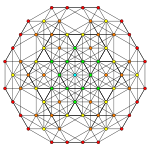Rectified 5-simplexes
 5-simplex |
 Rectified 5-simplex |
 Birectified 5-simplex |
| Orthogonal projections in A5 Coxeter plane | ||
|---|---|---|
In five-dimensional geometry, a rectified 5-simplex is a convex uniform 5-polytope, being a rectification of the regular 5-simplex.
There are three unique degrees of rectifications, including the zeroth, the 5-simplex itself. Vertices of the rectified 5-simplex are located at the edge-centers of the 5-simplex. Vertices of the birectified 5-simplex are located in the triangular face centers of the 5-simplex.
Rectified 5-simplex
| Rectified 5-simplex Rectified hexateron (rix) | ||
|---|---|---|
| Type | uniform 5-polytope | |
| Schläfli symbol | r{34} or  | |
| Coxeter diagram | or | |
| 4-faces | 12 | 6 {3,3,3} 6 r{3,3,3} |
| Cells | 45 | 15 {3,3} 30 r{3,3} |
| Faces | 80 | 80 {3} |
| Edges | 60 | |
| Vertices | 15 | |
| Vertex figure |  {}x{3,3} | |
| Coxeter group | A5, [34], order 720 | |
| Dual | ||
| Base point | (0,0,0,0,1,1) | |
| Circumradius | 0.645497 | |
| Properties | convex, isogonal isotoxal | |
In five dimensional geometry, a rectified 5-simplex, is a uniform 5-polytope with 15 vertices, 60 edges, 80 triangular faces, 45 cells (15 tetrahedral, and 30 octahedral), and 12 4-faces (6 5-cell and 6 rectified 5-cells). It is also called 03,1 for its branching Coxeter-Dynkin diagram, shown as ![]()
![]()
![]()
![]()
![]()
![]()
![]() .
.
E. L. Elte identified it in 1912 as a semiregular polytope, labeling it as S1
5.
The rectified 5-simplex, 031, is second in a dimensional series of uniform polytopes, expressed by Coxeter as 13k series. The fifth figure is a Euclidean honeycomb, 331, and the final is a noncompact hyperbolic honeycomb, 431. Each progressive uniform polytope is constructed from the previous as its vertex figure.
| n | 4 | 5 | 6 | 7 | 8 | 9 |
|---|---|---|---|---|---|---|
| Coxeter group |
A3A1 | A5 | D6 | E7 |  = E7+ = E7+ |
 =E7++ =E7++ |
| Coxeter diagram |
||||||
| Symmetry | [3−1,3,1] | [30,3,1] | [31,3,1] | [32,3,1] | [33,3,1] | [34,3,1] |
| Order | 48 | 720 | 23,040 | 2,903,040 | ∞ | |
| Graph |  |
 |
 |
 |
- | - |
| Name | −131 | 031 | 131 | 231 | 331 | 431 |
Alternate names
- Rectified hexateron (Acronym: rix) (Jonathan Bowers)
Coordinates
The vertices of the rectified 5-simplex can be more simply positioned on a hyperplane in 6-space as permutations of (0,0,0,0,1,1) or (0,0,1,1,1,1). These construction can be seen as facets of the rectified 6-orthoplex or birectified 6-cube respectively.
Images
 Stereographic projection of spherical form |
| Ak Coxeter plane |
A5 | A4 |
|---|---|---|
| Graph |  |
 |
| Dihedral symmetry | [6] | [5] |
| Ak Coxeter plane |
A3 | A2 |
| Graph | 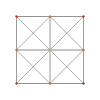 |
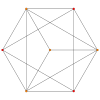 |
| Dihedral symmetry | [4] | [3] |
Birectified 5-simplex
| Birectified 5-simplex Birectified hexateron (dot) | ||
|---|---|---|
| Type | uniform 5-polytope | |
| Schläfli symbol | 2r{34} = {32,2} or  | |
| Coxeter diagram | or | |
| 4-faces | 12 | 12 r{3,3,3} |
| Cells | 60 | 30 {3,3} 30 r{3,3} |
| Faces | 120 | 120 {3} |
| Edges | 90 | |
| Vertices | 20 | |
| Vertex figure |  {3}x{3} | |
| Coxeter group | A5×2, [[34]], order 1440 | |
| Dual | ||
| Base point | (0,0,0,1,1,1) | |
| Circumradius | 0.866025 | |
| Properties | convex, isogonal isotoxal | |
The birectified 5-simplex is isotopic, with all 12 of its facets as rectified 5-cells. It has 20 vertices, 90 edges, 120 triangular faces, 60 cells (30 tetrahedral, and 30 octahedral).
E. L. Elte identified it in 1912 as a semiregular polytope, labeling it as S2
5.
It is also called 02,2 for its branching Coxeter-Dynkin diagram, shown as ![]()
![]()
![]()
![]()
![]() . It is seen in the vertex figure of the 6-dimensional 122,
. It is seen in the vertex figure of the 6-dimensional 122, ![]()
![]()
![]()
![]()
![]()
![]()
![]() .
.
Alternate names
- Birectified hexateron
- dodecateron (Acronym: dot) (For 12-facetted polyteron) (Jonathan Bowers)
Images
The A5 projection has an identical appearance to Metatron's Cube.[1]
| Ak Coxeter plane |
A5 | A4 |
|---|---|---|
| Graph |  |
 |
| Dihedral symmetry | [6] | [[5]]=[10] |
| Ak Coxeter plane |
A3 | A2 |
| Graph | 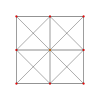 |
 |
| Dihedral symmetry | [4] | [[3]]=[6] |
Construction
 |
The birectified 5-simplex is the intersection of two regular 5-simplexes in dual configuration. The vertices of a birectification exist at the center of the faces of the original polytope(s). This intersection is analogous to the 3D stellated octahedron, seen as a compound of two regular tetrahedra and intersected in a central octahedron, while that is a first rectification where vertices are at the center of the original edges.
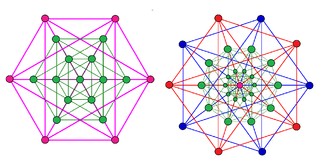 |
| Dual 5-simplexes (red and blue), and their birectified 5-simplex intersection in green, viewed in A5 and A4 Coxeter planes. The simplexes overlap in the A5 projection and are drawn in magenta. |
It is also the intersection of a 6-cube with the hyperplane that bisects the 6-cube's long diagonal orthogonally. In this sense it is the 5-dimensional analog of the regular hexagon, octahedron, and bitruncated 5-cell. This characterization yields simple coordinates for the vertices of a birectified 5-simplex in 6-space: the 20 distinct permutations of (1,1,1,−1,−1,−1).
The vertices of the birectified 5-simplex can also be positioned on a hyperplane in 6-space as permutations of (0,0,0,1,1,1). This construction can be seen as facets of the birectified 6-orthoplex.
Related polytopes
k_22 polytopes
The birectified 5-simplex, 022, is second in a dimensional series of uniform polytopes, expressed by Coxeter as k22 series. The birectified 5-simplex is the vertex figure for the third, the 122. The fourth figure is a Euclidean honeycomb, 222, and the final is a noncompact hyperbolic honeycomb, 322. Each progressive uniform polytope is constructed from the previous as its vertex figure.
| Space | Finite | Euclidean | Hyperbolic | ||
|---|---|---|---|---|---|
| n | 4 | 5 | 6 | 7 | 8 |
| Coxeter group |
2A2 | A5 | E6 |  =E6+ =E6+ |
 =E6++ =E6++ |
| Coxeter diagram |
|||||
| Symmetry | [[3<sup>2,2,-1</sup>]] | [[3<sup>2,2,0</sup>]] | [[3<sup>2,2,1</sup>]] | [[3<sup>2,2,2</sup>]] | [[3<sup>2,2,3</sup>]] |
| Order | 72 | 1440 | 103,680 | ∞ | |
| Graph |  |
 |
 |
∞ | ∞ |
| Name | −122 | 022 | 122 | 222 | 322 |
Isotopics polytopes
| Dim. | 2 | 3 | 4 | 5 | 6 | 7 | 8 |
|---|---|---|---|---|---|---|---|
| Name Coxeter |
Hexagon t{3} = {6} |
Octahedron r{3,3} = {31,1} = {3,4}  |
Decachoron 2t{33} |
Dodecateron 2r{34} = {32,2}  |
Tetradecapeton 3t{35} |
Hexadecaexon 3r{36} = {33,3}  |
Octadecazetton 4t{37} |
| Images |  |
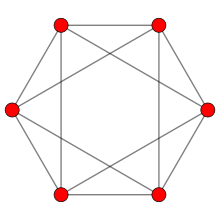  |
  |
  |
  |
 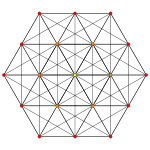 |
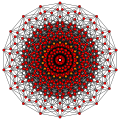  |
| Facets | {3} |
t{3,3} |
r{3,3,3} |
2t{3,3,3,3} |
2r{3,3,3,3,3} |
3t{3,3,3,3,3,3} | |
| As intersecting dual simplexes |
 |
 |
  |
Related uniform 5-polytopes
This polytope is the vertex figure of the 6-demicube, and the edge figure of the uniform 231 polytope.
It is also one of 19 uniform polytera based on the [3,3,3,3] Coxeter group, all shown here in A5 Coxeter plane orthographic projections. (Vertices are colored by projection overlap order, red, orange, yellow, green, cyan, blue, purple having progressively more vertices)
References
- ↑ Melchizedek, Drunvalo (1999). The Ancient Secret of the Flower of Life 1. Light Technology Publishing. p.160 Figure 6-12
- H.S.M. Coxeter:
- H.S.M. Coxeter, Regular Polytopes, 3rd Edition, Dover New York, 1973
- Kaleidoscopes: Selected Writings of H.S.M. Coxeter, edited by F. Arthur Sherk, Peter McMullen, Anthony C. Thompson, Asia Ivic Weiss, Wiley-Interscience Publication, 1995, ISBN 978-0-471-01003-6
- (Paper 22) H.S.M. Coxeter, Regular and Semi Regular Polytopes I, [Math. Zeit. 46 (1940) 380-407, MR 2,10]
- (Paper 23) H.S.M. Coxeter, Regular and Semi-Regular Polytopes II, [Math. Zeit. 188 (1985) 559-591]
- (Paper 24) H.S.M. Coxeter, Regular and Semi-Regular Polytopes III, [Math. Zeit. 200 (1988) 3-45]
- Norman Johnson Uniform Polytopes, Manuscript (1991)
- N.W. Johnson: The Theory of Uniform Polytopes and Honeycombs, Ph.D.
- Richard Klitzing, 5D, uniform polytopes (polytera) o3x3o3o3o - rix, o3o3x3o3o - dot
External links
- Glossary for hyperspace, George Olshevsky.
- Polytopes of Various Dimensions, Jonathan Bowers
- Rectified uniform polytera (Rix), Jonathan Bowers
- Multi-dimensional Glossary
| Fundamental convex regular and uniform polytopes in dimensions 2–10 | ||||||||||||
|---|---|---|---|---|---|---|---|---|---|---|---|---|
| Family | An | Bn | I2(p) / Dn | E6 / E7 / E8 / F4 / G2 | Hn | |||||||
| Regular polygon | Triangle | Square | p-gon | Hexagon | Pentagon | |||||||
| Uniform polyhedron | Tetrahedron | Octahedron • Cube | Demicube | Dodecahedron • Icosahedron | ||||||||
| Uniform 4-polytope | 5-cell | 16-cell • Tesseract | Demitesseract | 24-cell | 120-cell • 600-cell | |||||||
| Uniform 5-polytope | 5-simplex | 5-orthoplex • 5-cube | 5-demicube | |||||||||
| Uniform 6-polytope | 6-simplex | 6-orthoplex • 6-cube | 6-demicube | 122 • 221 | ||||||||
| Uniform 7-polytope | 7-simplex | 7-orthoplex • 7-cube | 7-demicube | 132 • 231 • 321 | ||||||||
| Uniform 8-polytope | 8-simplex | 8-orthoplex • 8-cube | 8-demicube | 142 • 241 • 421 | ||||||||
| Uniform 9-polytope | 9-simplex | 9-orthoplex • 9-cube | 9-demicube | |||||||||
| Uniform 10-polytope | 10-simplex | 10-orthoplex • 10-cube | 10-demicube | |||||||||
| Uniform n-polytope | n-simplex | n-orthoplex • n-cube | n-demicube | 1k2 • 2k1 • k21 | n-pentagonal polytope | |||||||
| Topics: Polytope families • Regular polytope • List of regular polytopes and compounds | ||||||||||||








